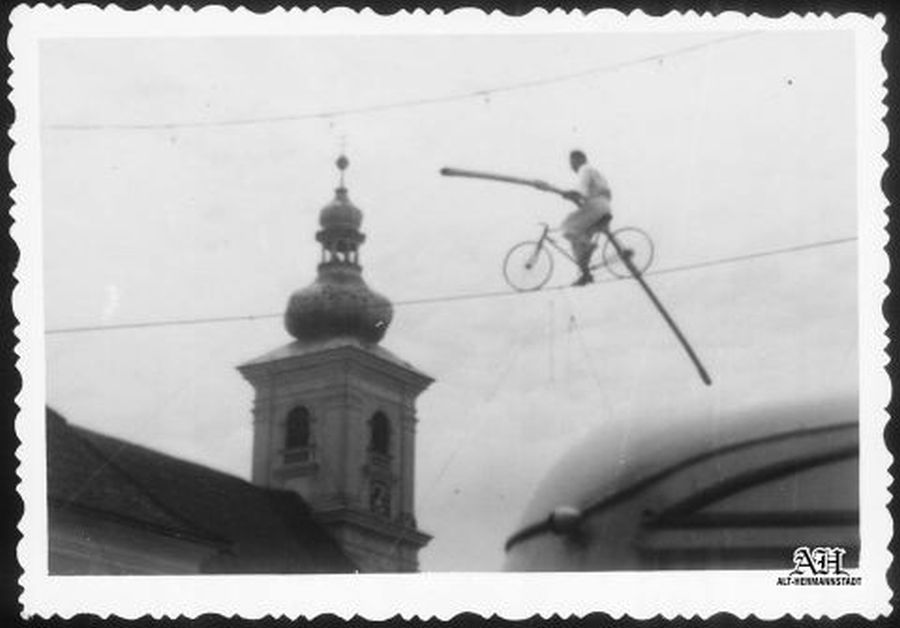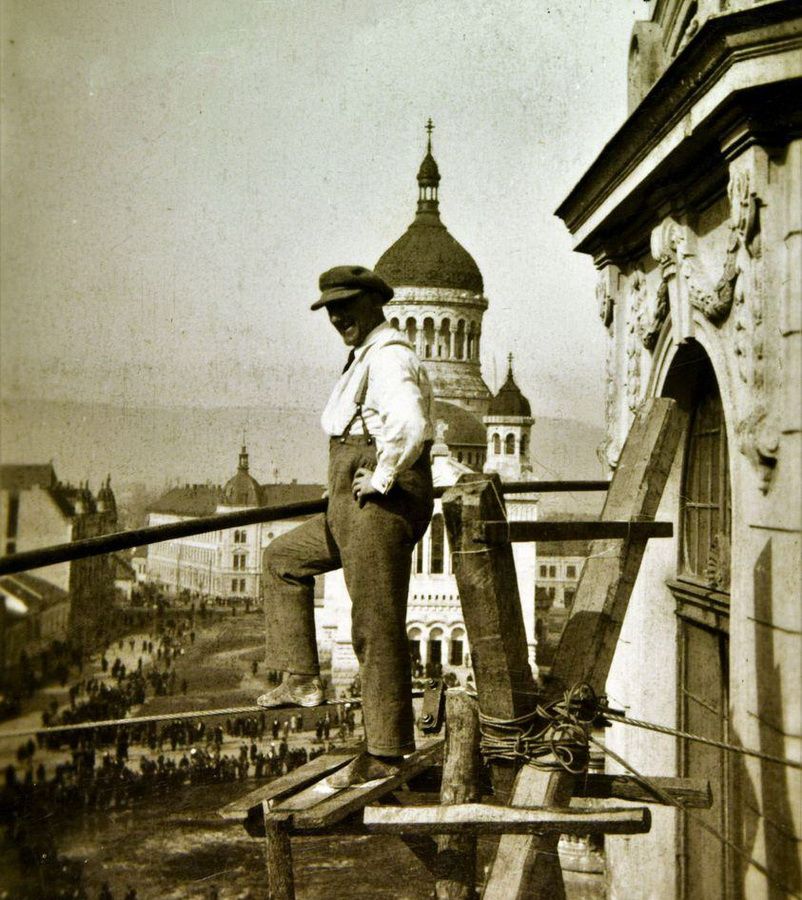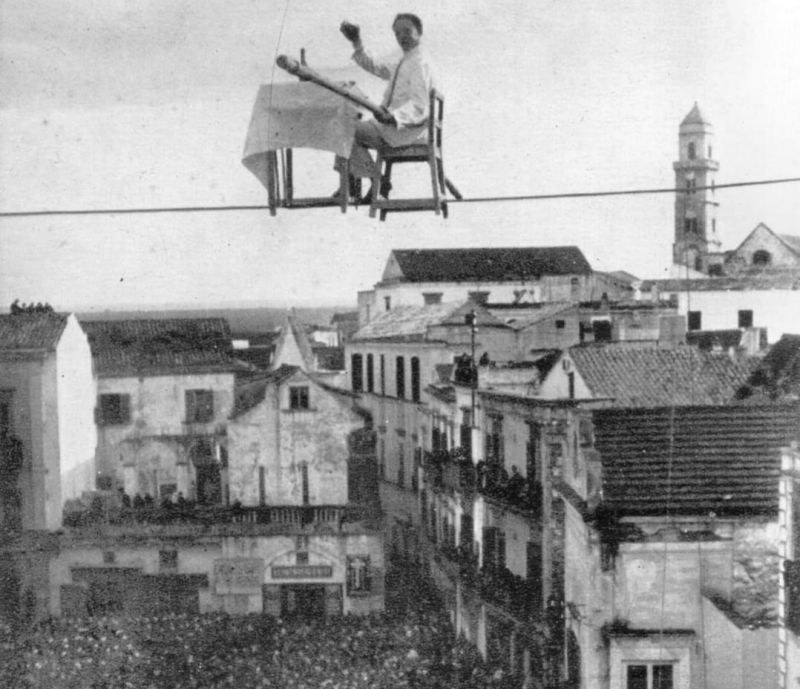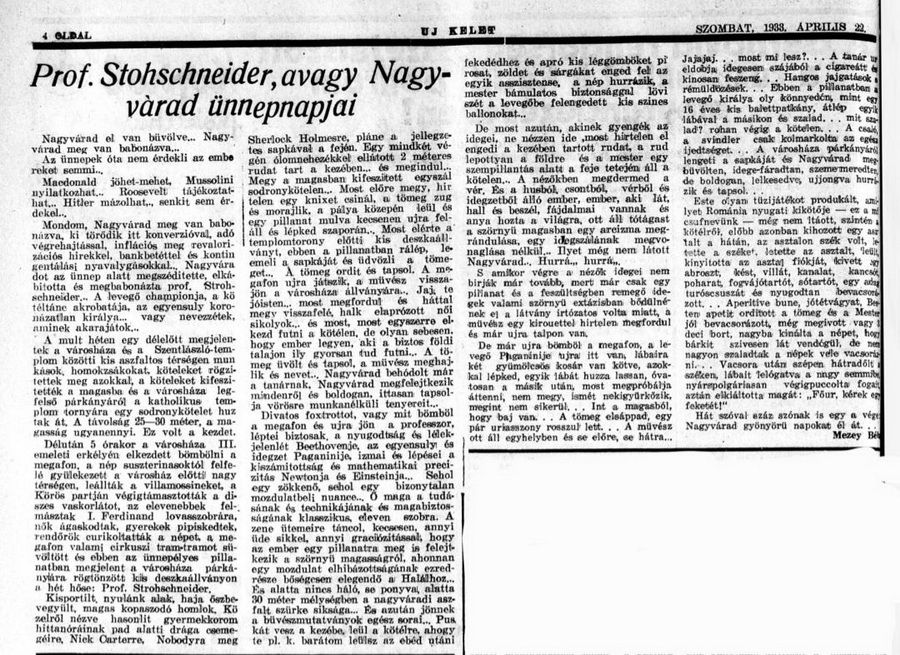91 years ago, on April 18, 1933, the people of Oradea witnessed an unprecedented event from then until today.
A world-renowned acrobat, Artur Strohschneider, nicknamed “The Professor”, performed a balancing act on a wire stretched between the City Hall building and the Roman Catholic church across the street.
The event was described in the press of the time, again Bihor publishes for the first time a rare image, captured during the show by the great-grandparents of a well-known Oradean.
On the wire, through the Great War
At the beginning of the 20th century, the press from all over Europe wrote about Artur Strohschneider that he was a real “showman”. According to information on the website of the Austrian municipality of Grundlsee, Strohschneider was born there in 1885 and was the most famous member of the family because of his high-altitude balancing acts on steel wires strung between buildings. His skill made him known by the nickname “The Professor”, and in the cities where he lived, large crowds of people gathered to watch him.
In an interview given to Italian journalists in May 1912 and quoted by the journalist Ruxandra Hurezean, who in 2019 published an article about Strohschneider in Sinteza magazine, “The Man Who Crossed the Great War by Wire”, the “Professor” said that he lived in Leitmeritz, in Bohemia, but only three months a year, “when he fished and grew,” while the remaining nine months he “lived” on the wire.
He learned acrobatics from the age of 9 and managed to keep thousands of people speechless with his performances. “It made them forget about war or famine. It made them believe that death could be defeated. It gave them courage”, says the quoted article about the tightrope.
The acrobat, during a show in Perugia, Italy (photo source: Revista Sinteza)
Tour in Europe
The press of the first decades of the last century wrote about Strohschneider that, when he arrived in a new city, he would stop in the central square and look for two buildings of similar heights, either parallel or in opposite corners.
He used to “sniff” the air, to find out if the weather would be favorable, and if the smell brought him a good prognosis, he would ask the town hall for an authorization for the show. As soon as he received it, he went to the offices of the local newspapers to announce his performance, specifying the day and time when he would go on the wire.
He was always accompanied by a large crew, which included a tin boy, a driver and a stuntman, and his wife and four children were also present in the audience. It is also said about him that he had a box for donations from the public, and from the collected money he donated a part to the poor in the locality where he gave the show.
Two postcards with the acrobat Artur Strohschneiderwhich are sold on antique sites
In the 30s, Artur Strohschneider was also on tour in Romania. After performances in Hungary, in Kecskemét (1931), Debrecen (1931) and Budapest (1932), in 1933 he arrived in Brașov, and a year later in Timișoara, in Cluj, in Maramureș, and even in Roșia Montană, on then a prosperous mountain town.
In the same year, 1933, on April 18, “The Professor” also had a show in Oradea, which was written about in the press of the time.
They forgot about poverty…
A chronicle of the show in the city on Crișul Repede was written by the journalist Mezey Béla for the Cluj-language daily Új Kelet (New Orient), in the April 22 edition, four days after the performance. “Prof. Strohschneider or the Oradea holidays” is the title of the article published on the fourth page of the newspaper, which shows that the people of Oradea were truly enchanted by the acrobat.
Mezey shows that, on the day of the performance, the people of Oradea did not care about the interviews given by Mussolini, what Hitler was doing or other “worldly” affairs: “In Oradea the world is bewitched, the world is not interested in inflation, the stock market, of the world’s problems. Oradea is bewitched by the fame and presence of the acrobat Prof. Strohschneider, the magician of balance on the rope, or whatever you want him to be called”.
The wire was stretched at a height of 25-30 meters, between the City Hall and the Church of Saint Ladislaus, and the show started after 5 p.m. At a window in the attic of the City Hall, music began to play, a sign for the citizens of Oradea to gather in the central square .
Strohschneider then appeared at the window, whom the journalist likened to Sherlock Holmes. “He took his 2 meter long bar with lead weights on both ends. And he started, walked forward on the rope, people looked down at him with bated breath. At one point he stopped, and in the middle of the distance he sat down and rested for a few moments. Then with increased steps he started and did not stop until he reached the church tower. He greeted the audience from the church tower, who applauded him. The world forgot about the fact that there is poverty, that there are no jobs, they applauded intensely and congratulated the artist”, wrote Mezey Béla.

An image from the performance given in Sibiu, in March 1933, shortly before the performance in Oradea (photo source: Revista Sinteza)
In the head, on a wire!
The performance continued, the journalist reporting that the acrobat turned and, “with a stylized appearance like Beethoven, with the calmness of Paganini, with the mathematical and physical precision of Newton and Einstein”, set off for the City Hall. In the middle of the distance, he did acrobatics, including a rifle in his hand, which appeared from no one knows where.
Then followed the climax, which the journalist from Cluj said was not recommended for the faint of heart. The teacher dropped the bar with which he was keeping his balance and put his head on the stretched wire. Then, he started walking towards the City Hall, but walking backwards!

The acrobat in Cluj, in 1934 (photo source: stiridecluj.ro)
“All this without a safety net, at a height of 30 meters. The public is very excited. When you feel that nothing more can happen, at some point the artist receives two fruit baskets. He tries to put them on his foot, but he feels that something is wrong,” Mezey recorded, without elaborating on how he received the two baskets of fruit.
Dinner at a height
Instead, the reporter noted that several people in the crowd were unable to watch the show, which did not stop the acrobat from performing. She was unable to walk backwards, however, “like a young ballerina, she turns and starts running on the wire.” When he arrived at City Hall, the public was ecstatic.
The show ended with fireworks, also unprecedented in western Romania, as Mezey wrote, and then, when the people of Oradea thought it was over, the “Professor” carried a chair up the wire and began to eat his dinner, at height!

The dinner at the top was part of the acrobat’s show, a moment he reproduced in many of the cities where he stayed (photo source: pattimccracken.com)
“He also invites the spectators to dinner, but no one dares to climb that high, especially on a rope,” the journalist wrote. Eating on the rope was a moment that the tightrope walker often reproduced in his performances, as evidenced by the testimonies from other cities where he stopped (photo).
Mezey also drew the conclusion of the day: “On hard days, Oradea also has sunny days.” The city was, like all of Europe, in the midst of the interwar period, and life was not easy at all. Good luck with the acrobat who brought excitement to the city for a while.

The article published in the newspaper Uj Kelet about the performance given in the Unirii Square in Oradea (source: BCU Cluj)
Testimony from the past
The article in Új Kelet was not accompanied by any photographs, which were still quite rare at the time. A well-known person from Oradea discovered, however, among the things inherited from his grandparents, a photo that shows Strohschneider doing his balancing act on the wire in Piata Unirii!
“I don’t know who was present at this event. It is certain that either my grandfather or my grandmother personally saw this performance, the photo being taken by one of their parents”, says Thurzó Zoltán (photo)famous pianist from Oradea, holder of some world records.
Zoltán inherited the heritage of his maternal grandparents, the musicologist Thurzó Sándor and the opera singer Tyukodi Margit, and sorting through tens of thousands of documents, posters, photographs and other objects, he found the photograph of Strohschneider in Oradea. “If my grandfather saw the show, he was 13. If it was the grandmother, she was 12 years old,” says Thurzó, who presented the image BIHOREAN. His grandparents never told him about this show, though, so he has no other details.
The small-sized photo has good sharpness, capturing the acrobat as he walks the wire towards the tower of St. Ladislaus Church, holding the long pole on which he balances. A proof that the famous “Professor” was here and kept the people of Oradea at bay…
HOW DID HE DIE?
Two stories about the death of the Professor
Information about the fate of the acrobat Artur Strohschneider is contradictory. Some sources say that he died in 1934, after a performance in Reșita, where he allegedly fell and broke his arm. He wanted to be treated in Budapest, but on the way he fell ill with pneumonia and would have died in a sanatorium in Hungary.
The same website of the local administration of Grundlsee shows, instead, that Strohschneider would have died in 1952, so at the age of 67, without specifying any other information. It seems that his death was no longer as spectacular as his life…











